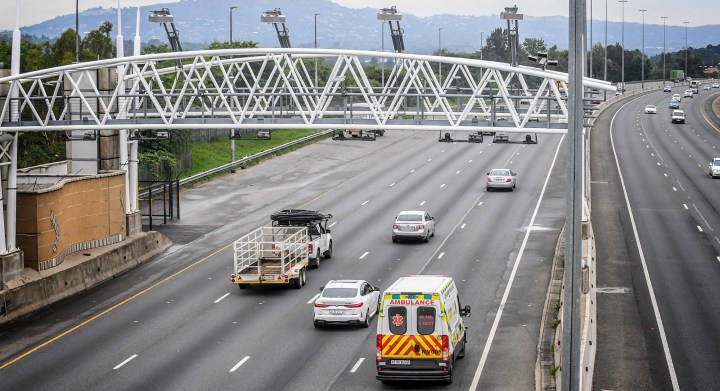HIGHWAY TRAVAILS
End of e-tolls creates a funding headache for Gauteng roads

According to the SA National Roads Agency, 85% of Gauteng’s roads are beyond their design life cycle and need significant maintenance investments. How this will be funded remains a big mystery.
The R23.7-billion bailout that Finance Minister Enoch Godongwana threw to the SA National Roads Agency (Sanral) will free the national government from being responsible for the future maintenance of Gauteng’s 201km of e-tolled freeways.
To recap: Godongwana greenlighted a plan that involves the national government taking over responsibility for 70% of Sanral’s debt that the state-owned enterprise (SOE) has clocked up through the expansion and maintenance of Gauteng roads. To do this, Godongwana has allocated an initial R23.7-billion taxpayer-funded bailout to pay Sanral’s debt and interest costs.
The Gauteng government has agreed to be responsible for the other 30% of Sanral’s debt, as well as the maintenance and regular inspection of freeways, bridges and slopes in the province — an exercise that costs at least R3-billion every year. This arrangement will pave the way for the national government to be taken out of the e-toll saga and for the Gauteng government to be squarely responsible for the upkeep of road infrastructure.
But the arrangement will also create a headache for the provincial government that Gauteng Premier Panyaza Lesufi didn’t consider when he declared on Twitter that e-tolls “are gone”. It is not yet clear whether the Gauteng government has the financial muscle to pay 30% of Sanral’s debt and the annual R3-billion maintenance bill; where the money will be sourced from, in the light of the province’s deteriorating purse; and where motorists will fall in this funding matrix.
What is clear is that if there is no credible plan for how these questions will be addressed, the consequences will be dire for SA’s economy and the roll-out of crucial infrastructure projects. Well-functioning and maintained freeways are key for economic activity because they link producers to markets, workers to jobs, students to schools, and contribute to a country’s developmental agenda.
Start of the e-toll saga
Since its launch in 1998, Sanral successfully planned, financed, developed and maintained more than 20,000km of the national road network — comprising tolled and untolled roads. But from October 2007, SA roads and freeways (especially in Gauteng) became highly political and controversial. At the time, the Gauteng Freeway Improvement Project (GFIP) was launched by the government, which introduced an electronic tolling system that would charge Gauteng motorists (barring minibus taxis and buses) for the use of new highways in the province. This would be a departure from the practice of motorists being charged nationally through taxes.
The GFIP faced delays, with an initial implementation target of 2011, which was later pushed to 2013. The road tolling project faced pushback from the business community, motorists and trade unions — pushback which also inspired the launch in 2012 of the Opposition to Urban Tolling Alliance (Outa), a civil society organisation.
Protests against e-tolls were growing at a time when corruption and the wastage of taxpayer funds worsened during the Jacob Zuma presidency. The prevailing argument was that the plundered taxpayer money could have funded necessary improvements to Gauteng freeways, but the funds generally enriched politically connected individuals and State Capture architects. This led to e-tolls being snubbed by motorists refusing to comply with the system.
Visit Daily Maverick’s home page for more news, analysis and investigations
Sanral’s latest results show that compliance with e-tolls reached 17.65% and the scheme has accumulated R9.7-billion in uncollectable debt from motorists who have refused to pay their e-toll bills since 2013. Only 7% of Sanral’s more than 20,000km road network is tolled. And Sanral’s untolled roads are funded through grants received from the national fiscus (or public finances) and money raised by the SOE in debt capital markets.
Sanral has since pumped in R22.4-billion to fund the GFIP’s build and to plug any gaps created by the uncollectable e-toll debt. In July 2022, the SOE pumped a further R3.74-billion into the GFIP — funds that were raided from the government’s grants that were earmarked for funding untolled roads.
A large portion of the billions of rands that went into bankrolling the GFIP was borrowed from the bond market. In this market, lenders ordinarily buy Sanral’s debt on the open market with an expectation of being repaid the purchase amount and interest at a later stage by the SOE. The borrowings by Sanral in the bond market are guaranteed by the government, meaning that if it fails to pay back lenders, the government will be on the hook for payments.
Outstanding questions about how roads will be funded
Back to Godongwana’s R23.7-billion bailout for Sanral. Much of the bailout will go towards paying down Sanral’s debt or bonds worth up to R8-billion that will mature in the next three to five years. The aim of this is to reduce Sanral’s debt load so that the Gauteng government is not saddled with the responsibility of large debt repayment obligations while also being responsible for the upkeep of road infrastructure. It is also aimed at paving the way for the Gauteng government to roll out road construction projects in the province, mainly the maintenance of freeways.
Wayne Duvenage, the Outa CEO, sees the bailout of Sanral and shifting of the maintenance responsibility of freeways (and funding of this endeavour) to the Gauteng government as the end of e-tolls. If it’s not the end of e-tolls, it is at least the end of the entire “user pay” revenue model on which the GFIP was based from the start.
Duvenage says the end of the e-tolls has two aspects: establishing the alternative funding solution for the GFIP (which has two more phases of road infrastructure investments), and the legal requirements of dismantling e-tolls.
“The Minister of Transport, Fikile Mbalula, should now announce the way forward to legalise the situation for users of the Gauteng tolled roads. Outa believes that Sanral and the Department of Transport must now retract the notices which declared the GFIP roads as toll routes, which enabled tolls to be charged. This is Sanral’s responsibility, in consultation with the minister.”
E-toll roads in Gauteng make up 1% of Sanral’s national network. The Gauteng road network is in desperate need of sprucing up, which will be a costly exercise. According to Sanral, 85% of Gauteng’s roads are beyond their design life cycle and need significant maintenance investments. The funding of this exercise remains a big mystery. DM168


















User pays, fuel levy
How about the make up of the fuel price which includes a levy for road maintenance and development. The general fuel levy (not the Road Accident Levy) generated R80 billion for government in 2019/20, accounting for about 6% of total tax revenue. Instead of being swallowed into the general revenue coffers this should be earmarked for road maintenance and development of new roads and accounted for as such. There is already a VAT component to the fuel price ostensibly for general revenue funding.
Congratulations Ray on a balanced and rational article which tells the story as it is. Unfortunately, the public has been led astray on this matter by OUTA and the AA. I would like to see how they will now suggest resolving the problems faced into the future by Gauteng residents if they want to avoid a crumbling road system. The provincial politicians have had a fast one pulled over them by the Minister of Finance and his personnel in the department. The dedication of the fuel levy is to roads is in my opinion not an option since Treasuries throughout the world dislike dedication of public funds as this reduces their “allocative powers”. In the end the tolls on GFIP will be restored, but only after 2024. OUTA and the AA whilst doing much good work have played politics in this issue. Also Ray, one correction in your article, SANRAL itself did not bring into being the 20 000 km of National Roads. They only took over and continued in 1998 the work previously carried out by the Chief Directorate of National Roads in the DoT as an agent for the NTC during the past many decades.